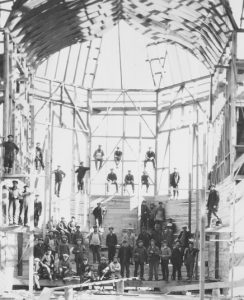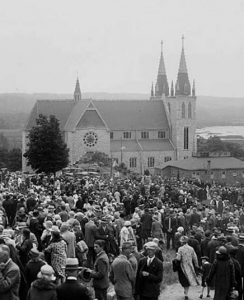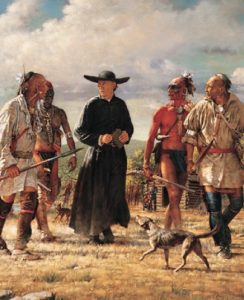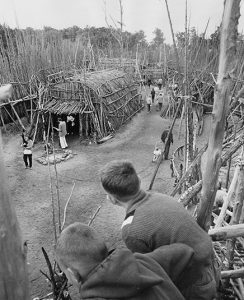In 1534, Jacques Cartier began the first of three expeditions to explore the territory that would briefly be known as New France. Though his attempts at settlement failed, Cartier—depicted here erecting a cross in the village of Stadacona, where the city of Quebec now stands—was the first to accurately map…
Read More
About Us > History of Martyrs' Shrine
History of Martyrs' Shrine
Martyrs' Shrine has been a holy and historic place of worship for nearly 100 years and continues a nearly 400 year story of love and discovery with St. Jean de Brébeuf and his companions. There is much to discover and explore, and on this page we can only give you a glimpse into the Shrine's rich history.
A number of Jesuit Fathers starting with P. Chazelle first attempted to identify the remnants of Indigenous villages and European ruins with the documentation found in the Jesuit Relations. Date: 1660 In the early decades of the 17th century, as European explorers and missionaries set foot in the vast…
Read More
Le Massacre des Hurons par les Iroquois, Joseph Legare (1827). The mid‑17th century was a time of great turmoil and transformation for the Wendat (Huron) people and the Jesuit missionaries who had established deep, albeit fraught, bonds with them. In the wake of epidemics, relentless Haudenosaunee (Iroquois) assaults, and shifting…
Read More
The Martyrs’ Shrine that you see on the hill today in Midland, Ontario replaced a much smaller Shrine by the same name in Waubaushene, about 12km from the present Shrine. In 1907, Archbishop Denis O’Connor of Toronto blessed this small chapel near the site of martyrdom of Fathers Jean de…
Read More
In June of 1925, Father John M. Filion, then Provincial Superior of English speaking Jesuits across Canada, felt the need for a larger shrine that would be closer both to pure spring water and to the Sainte-Marie mission. Filion purchased the Standin brothers’ farm on the hill across the road…
Read More
On June 21, 1925 the Canadian Martyrs were beatified (declared blessed and worthy of public worship) in Rome by Pope Pius XI. On that day a monument was unveiled at Sainte-Marie. 6,000 people were present that day at Sainte-Marie for the ceremony and an open-air Mass on a covered platform.…
Read More
On June 26, 1926 in advance of Fr. Filion’s deadline, the church was finally built. It was a long fall and winter season for Fr. Filion and the tradesmen battling the Canadian weather to erect the Shrine church in time. On the following day, June 27, the weather turned warm…
Read More
Nearly four years to the day later, on June 29, 1930, as Pope Pius XI was canonizing the eight Canadian Martyrs in St. Peter’s Basilica in Rome, another vast congregation gathered in front of the altar at the 12th Station of the Cross on the hill overlooking Georgian Bay. Once…
Read More
At the end of the Depression, it took three years of appeals for director, Fr. Lally to collect the $4,000 purchase price of the Sainte-Marie property from a local businessman. It was a top priority. With the site now finally back in Jesuit hands in 1940, Fr. Lally wanted archaeologists…
Read More
In 1964 the Jesuits negotiated an agreement between the Upper Canadian Province of Jesuits and the Government of Ontario whereby the historic site of Sainte-Marie and adjoining land on the south side of highway 12 were leased to the Provincial Government for 100 years for a consideration of one dollar.…
Read More
"This Martyrs' Shrine of Huronia bears witness to the rich heritage that has been handed on to the whole Church. At the same time it is a place of pilgrimage and prayer, a monument to God's blessings in the past, an inspiration as we look to the future..." - Pope John Paul II








